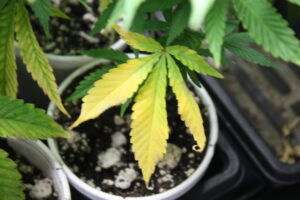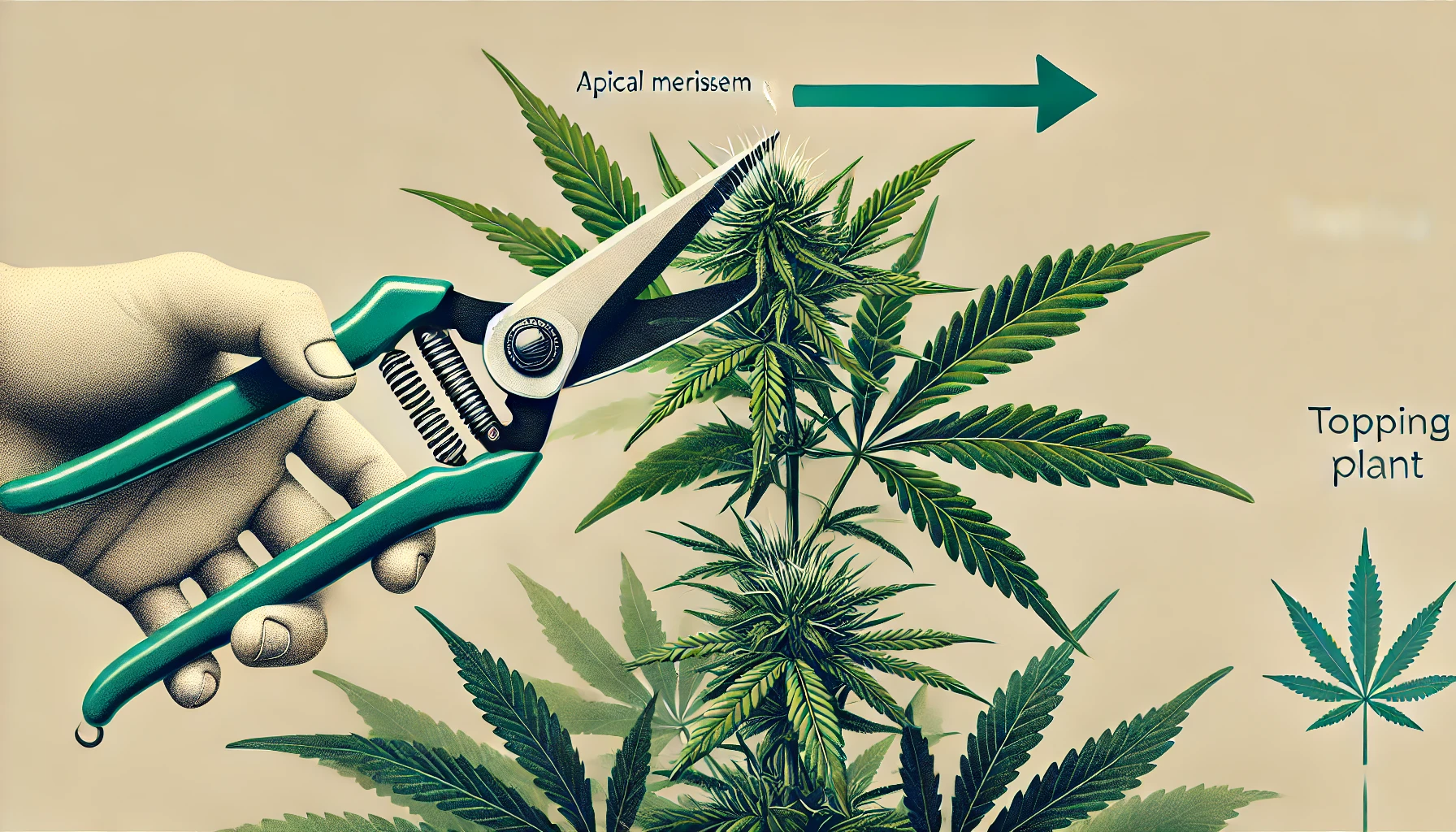
In advanced cannabis cultivation, the focus is on optimizing every aspect of plant development. Techniques such as main-lining, ScrOG, supercropping, defoliation, lollipopping, and monster cropping go beyond boosting yields; they enhance plant health and bud quality. These methods require a deep understanding of cannabis physiology and careful stress management to maximize the plant’s genetic potential.
Implementing these advanced techniques demands precision and adaptability. The goal is to cultivate excellence, challenging the limits of cannabis cultivation. Whether you’re aiming for higher yields or refining your skills, these methods offer a comprehensive toolkit for achieving outstanding results. Let’s explore how these techniques can elevate your growing experience.
Table of Contents
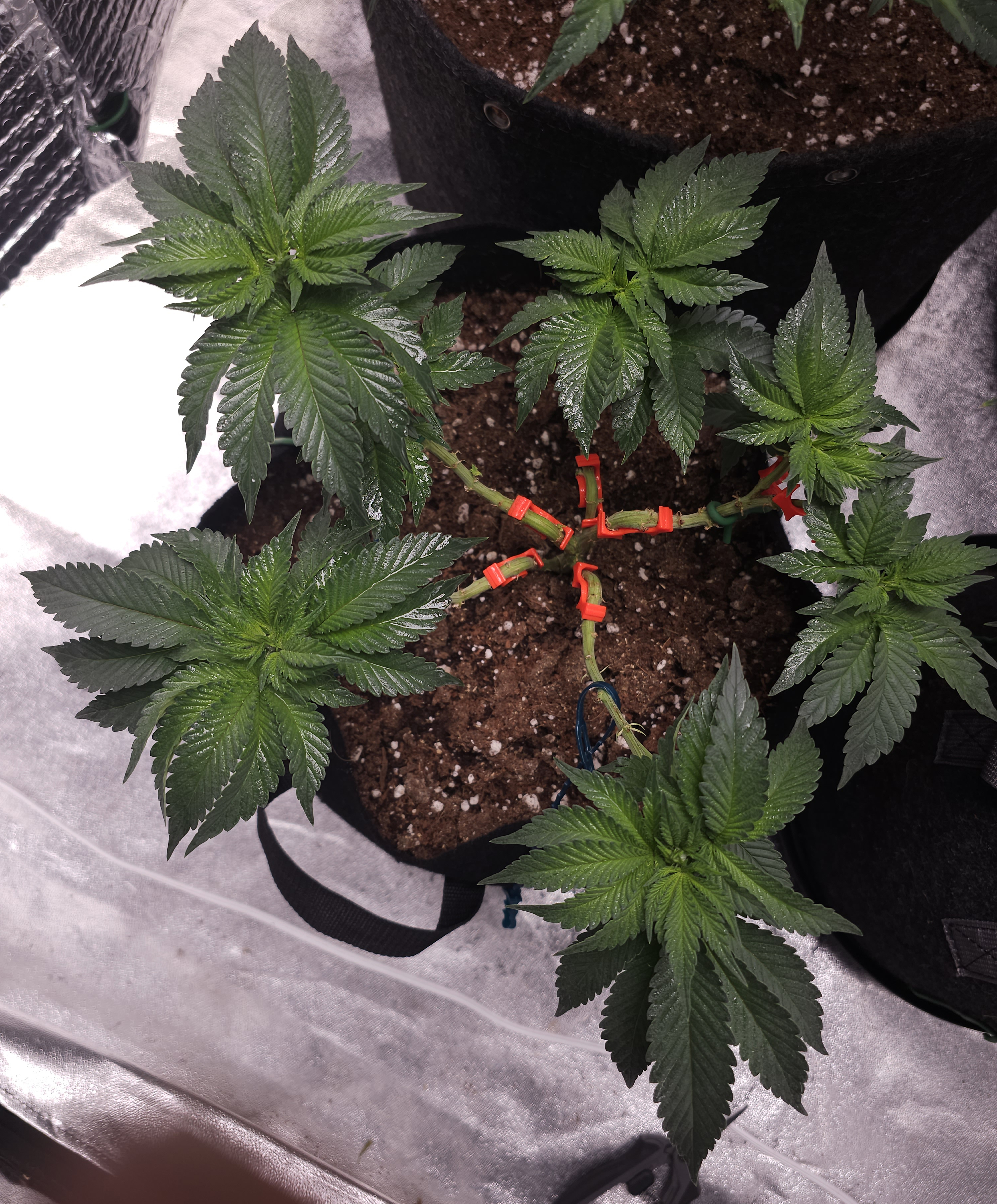
1. Main Lining a.k.a. Manifolding
At the heart of advanced cannabis cultivation lies the technique of Main Lining or Manifolding, a method that epitomizes the marriage of art and science in the world of gardening. This technique is not just about growing cannabis; it’s about sculpting it and guiding each plant to realize its fullest potential through strategic manipulation and care.
Description
Main lining begins with a simple yet profound act: topping the cannabis plant early in its growth stage. This initial topping is more than just a cut; it’s the first step in a meticulous process of creating a “manifold” – a foundation from which the plant will flourish symmetrically. By carefully pruning the plant to form two main branches, and subsequently topping these branches, a grower can create a hub-like structure. This structure serves as a conduit for nutrients and energy, distributing these vital resources evenly across the plant.
Benefits
The benefits of Main Lining are manifold (pun intended). Firstly, this technique ensures uniform growth and bud development across the entire plant. This uniformity is not just aesthetically pleasing; it’s highly practical, leading to a more predictable and, often, increased yield. With each branch receiving an equal share of the plant’s resources, no energy is wasted, and each bud site has the potential to develop to its maximum capacity.
Moreover, Main Lining optimizes light distribution. In indoor setups, where light is a precious commodity, ensuring that each part of the plant receives adequate exposure is crucial. The symmetrical structure created through Main Lining achieves this beautifully, making the most of the available light and often reducing the need for additional light sources.
Implementing Main Lining
- Start Early: Begin the Main-Lining process when the plant has developed 3-4 nodes. This early start is crucial for shaping the plant’s growth effectively.
- First Topping: Carefully cut the main stem above the second or third node, ensuring a clean cut to promote healthy regrowth.
- Training the Branches: As the two new main branches grow, use ties or soft plant wire to gently guide them outward in opposite directions. This training encourages the development of the manifold.
- Subsequent Toppings: Once these branches have developed their own sets of nodes, repeat the topping process on each new leading branch. Continue this pattern until you’ve achieved the desired number of main branches.
Considerations
While Main-Lining can dramatically improve the quality and quantity of your yield, it requires patience and precision. Each cut must be made with care to avoid unnecessary stress on the plant, and the grower must be vigilant in monitoring the plant’s response to ensure it remains healthy and vibrant.
Through Main-Lining, cannabis cultivation transcends its agricultural roots to become an art form, where each grower’s hand shapes the destiny of their plants. This technique, though demanding, offers a pathway to unparalleled satisfaction in the grow room, as each plant reaches its zenith of growth and productivity.
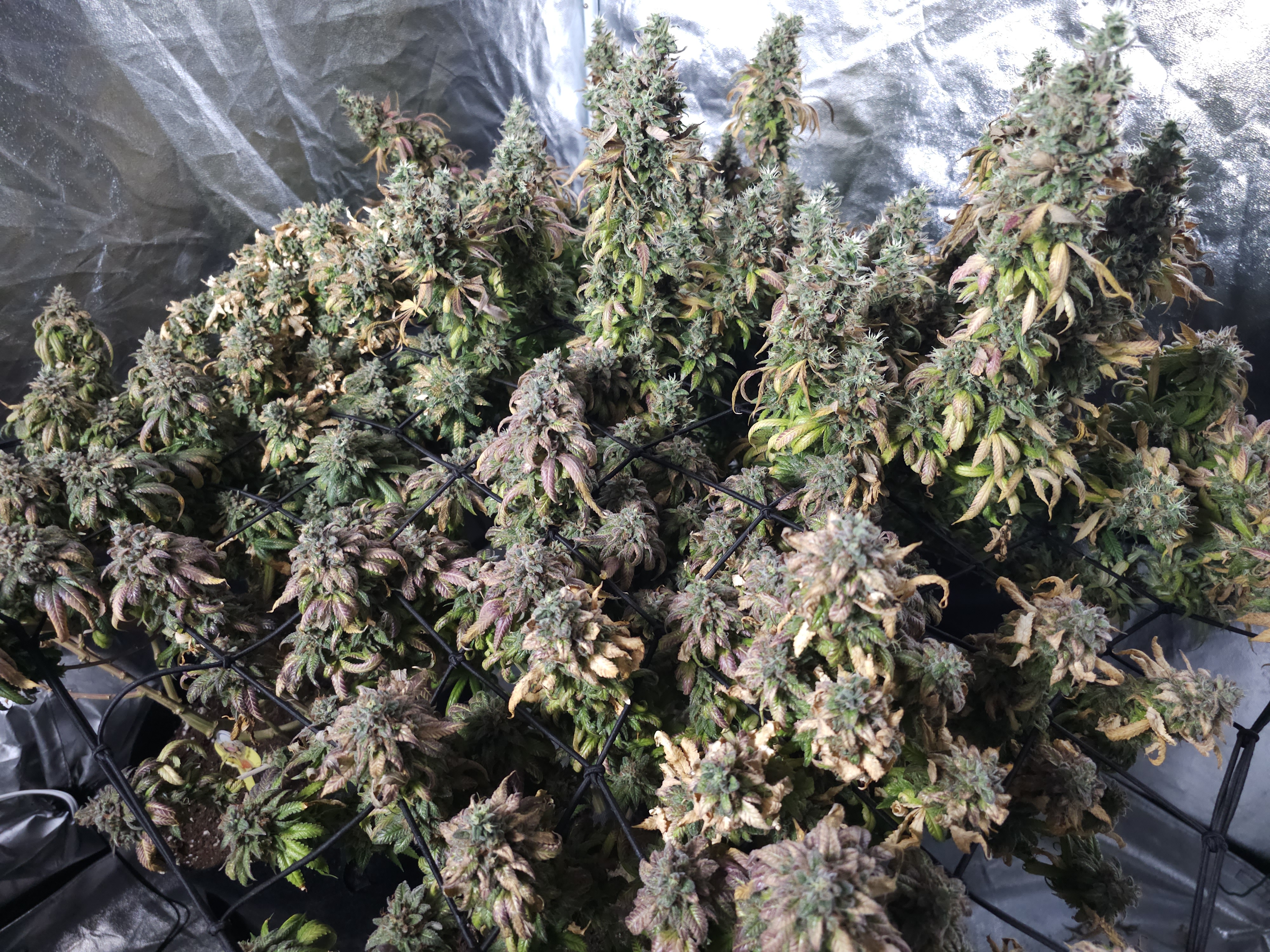
2. Screen of Green (ScrOG)
The Screen of Green, affectionately known as ScrOG, is a cannabis training technique revered for its simplicity and effectiveness. This method embodies the philosophy that with the right support, any plant can reach its full potential. By integrating a screen into the growing process, ScrOG transforms the cannabis canopy into a flat, even plane that maximizes light exposure and optimizes plant health.
Description
The ScrOG technique involves placing a horizontal screen or net above the growing cannabis plants at a predetermined height. As the plants grow taller, their branches are gently woven through the openings of the screen. This not only supports the plants but also spreads the canopy outwards, creating a uniform layer of growth. The screen acts as a guide, encouraging the plant to grow horizontally rather than vertically.
Benefits
The primary advantage of the ScrOG method is its ability to maximize light exposure to all parts of the plant. In a traditional growing setup, the upper leaves and branches can overshadow lower parts, leading to uneven growth and potential wasted energy. ScrOG eliminates this issue by ensuring that each branch and bud site receives an equal opportunity to thrive, resulting in a healthier plant and a more uniform bud development.
Additionally, ScrOG improves air circulation around the plants. By spreading the branches, the method opens up the canopy, allowing air to flow freely through the grow space. This not only reduces the risk of mold and pest infestations but also enhances the overall environmental conditions for optimal plant growth.
Implementing ScrOG
- Setting Up the Screen: Install a screen or net above your plants at a height of approximately 20-25 inches (50-63 cm) from the base. Ensure it’s securely fastened and can support the weight of your plants as they grow.
- Weaving the Branches: As your plants grow through the screen, gently weave the branches through the openings, spreading them out across the horizontal plane. Be careful not to break the stems.
- Pruning Underneath: Remove any growth below the screen that doesn’t receive adequate light. This focuses the plant’s energy on the canopy, where bud development is concentrated.
- Maintaining the Canopy: Continue to guide and spread the branches as they grow, maintaining an even canopy across the screen. This may involve additional trimming and weaving to optimize light exposure and plant health.
Considerations
While ScrOG is an incredibly effective method for maximizing yield and improving plant health, it requires diligence and patience. Regular attention is needed to guide the plants through the screen, and a gentle touch is essential to avoid damaging the branches. Additionally, growers must be mindful of the spacing between plants; overcrowding can undermine the benefits of ScrOG by creating competition for light and resources.
The Screen of Green method is a testament to the power of support and guidance in cannabis cultivation. By providing plants with the structure they need to spread and flourish, ScrOG unlocks their full potential, leading to lush, productive grow operations that stand as a proud testament to the grower’s skill and dedication.
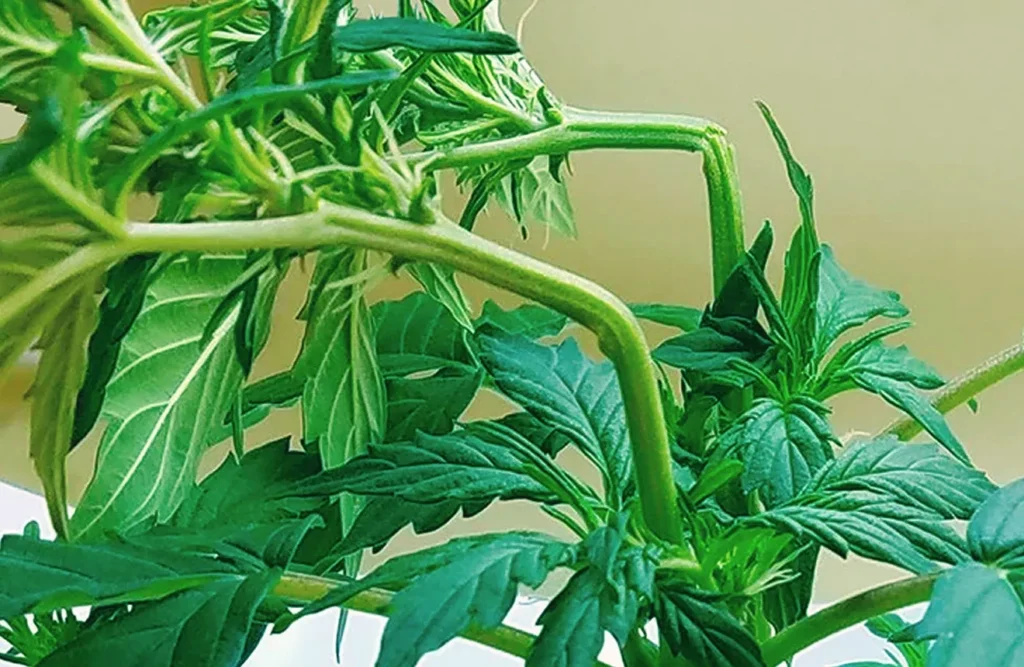
3. Supercropping
Supercropping stands out as a high-stress training (HST) technique that pushes cannabis plants beyond their limits, only to result in stronger, more resilient growth. This method is akin to the adage “what doesn’t kill you makes you stronger,” applied directly to plant training. By intentionally inflicting stress on the plants through precise manipulation, growers can significantly enhance their structural integrity and overall bud quality.
Description
Supercropping involves carefully bending and pinching the plant’s branches to damage the inner tissues without breaking the skin. This controlled damage causes the plant to go into a rapid repair mode, strengthening the area around the “injury” and creating a knuckle-like growth. These knuckles not only serve as a testament to the plant’s resilience but also improve the nutrient and water flow within the plant, leading to healthier, more vigorous growth.
Benefits
The benefits of supercropping are multifaceted. Firstly, it allows growers to control the height and shape of their plants more effectively. In environments where space is limited or light distribution is a concern, being able to direct the growth of the plant can make a significant difference in the overall success of the grow operation.
Furthermore, the increased resilience and enhanced nutrient flow contribute to larger bud development and potentially higher yields. Plants that undergo supercropping often exhibit a robustness that is not seen in plants grown using more traditional methods. The stress induced by supercropping also triggers the plant’s natural defense mechanisms, potentially leading to increased potency and terpene production.
Implementing Supercropping
- Timing: The best time for supercropping is during the vegetative growth phase when the plants are most flexible and resilient. Avoid supercropping once flowering has begun, as this can stress the plant unnecessarily and impact bud development.
- Selecting the Branches: Choose healthy, vigorous branches that are getting too tall or are blocking light to lower parts of the plant. These are your prime candidates for supercropping.
- The Technique: Gently but firmly grasp the stem between your thumb and forefinger at the chosen point. Bend the stem over to a 90-degree angle, being careful not to snap it. You may hear a slight cracking sound; this is normal.
- Support: After bending, the branch will need support to stay in its new position. Use plant ties or soft wire to secure it in place if necessary.
- Recovery: Allow the plant time to recover from the stress. Within a few days, you should see the formation of the knuckle and notice that the branch begins to turn back up towards the light.
Considerations
While supercropping is an effective technique, it’s not without its risks. It requires a careful hand and a good understanding of plant biology to be executed successfully. Overdoing it or applying the technique at the wrong time can lead to stressed plants and reduced yields. It’s also crucial to maintain a clean environment when handling the plants to prevent the introduction of pathogens.
Supercropping is a testament to the resilience of cannabis plants and the ingenuity of growers. By carefully applying stress, growers can sculpt their plants into hardy, productive specimens that are optimized for their growing conditions.
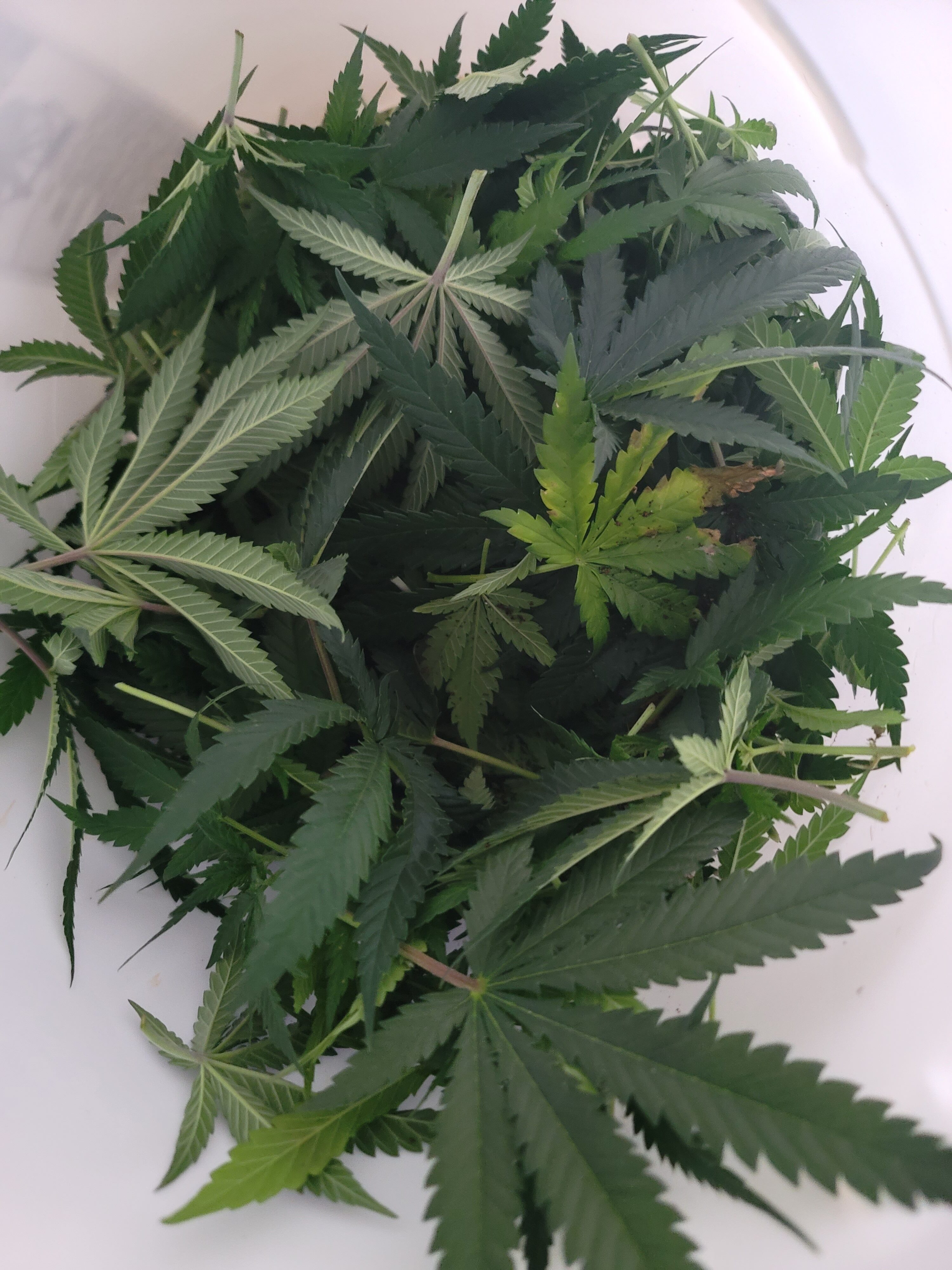
4. Defoliation
Defoliation is a strategic approach to cannabis cultivation that focuses on the selective removal of leaves to enhance plant health, light penetration, and ultimately, yield. This technique is based on the principle that not all leaves are beneficial for the plant’s growth at all stages, especially when they overshadow bud sites or hinder airflow within the canopy.
Description
The process of defoliation involves carefully pruning away certain leaves from the cannabis plant. This is done in two critical phases: once during the vegetative stage to shape the plant and improve airflow, and again in the early flowering stage to expose bud sites to more light. By removing leaves that block light from reaching lower bud sites or contribute to excessive humidity within the canopy, growers can significantly improve the overall health and productivity of their plants.
Benefits
The primary benefit of defoliation is the improved light penetration and airflow it provides. In dense canopies, lower leaves and bud sites can suffer from a lack of light, limiting their growth and development. By strategically removing leaves, growers ensure that light and air can reach all parts of the plant, leading to more even growth and potentially larger yields.
Moreover, defoliation can help reduce the risk of mold and pest infestations. Dense foliage can create microenvironments within the canopy that are conducive to mold growth and pest proliferation. By opening up the plant’s structure, defoliation promotes a drier and more aerated environment, which is less inviting to pests and pathogens.
Implementing Defoliation
- Vegetative Stage Defoliation: Begin by removing large fan leaves that are overshadowing bud sites or blocking light to lower branches. Focus on leaves that are inward-facing or contribute to dense pockets of foliage.
- Flowering Stage Defoliation: Once the plant has entered the early stages of flowering, perform a more cautious round of defoliation. Remove leaves that are directly blocking light to developing bud sites, but be careful not to overdo it, as the plant needs its leaves for photosynthesis.
- Technique: Use clean, sharp scissors or pruning shears to make clean cuts close to the stem. This minimizes stress and promotes quick healing.
- Moderation: It’s essential to defoliate in moderation. Removing too many leaves can stress the plant and reduce its photosynthetic capacity, negatively impacting growth and bud development.
Considerations
Defoliation is a powerful technique when used correctly, but it requires a nuanced understanding of plant health and growth patterns. Over-defoliating can lead to stressed plants and reduced yields, so it’s crucial to approach this method with caution and to observe the plant’s response closely.
The timing of defoliation can also significantly impact its effectiveness. Removing leaves too early or too late in the growth cycle can hinder the plant’s development. Therefore, timing defoliation to coincide with key growth phases ensures that the plants benefit fully from this technique.
Defoliation exemplifies the balance between intervention and natural growth, offering growers a tool to guide their plants toward optimal health and productivity. By judiciously removing leaves, cultivators can encourage their cannabis plants to focus their energy where it matters most: on the development of potent, resinous buds.
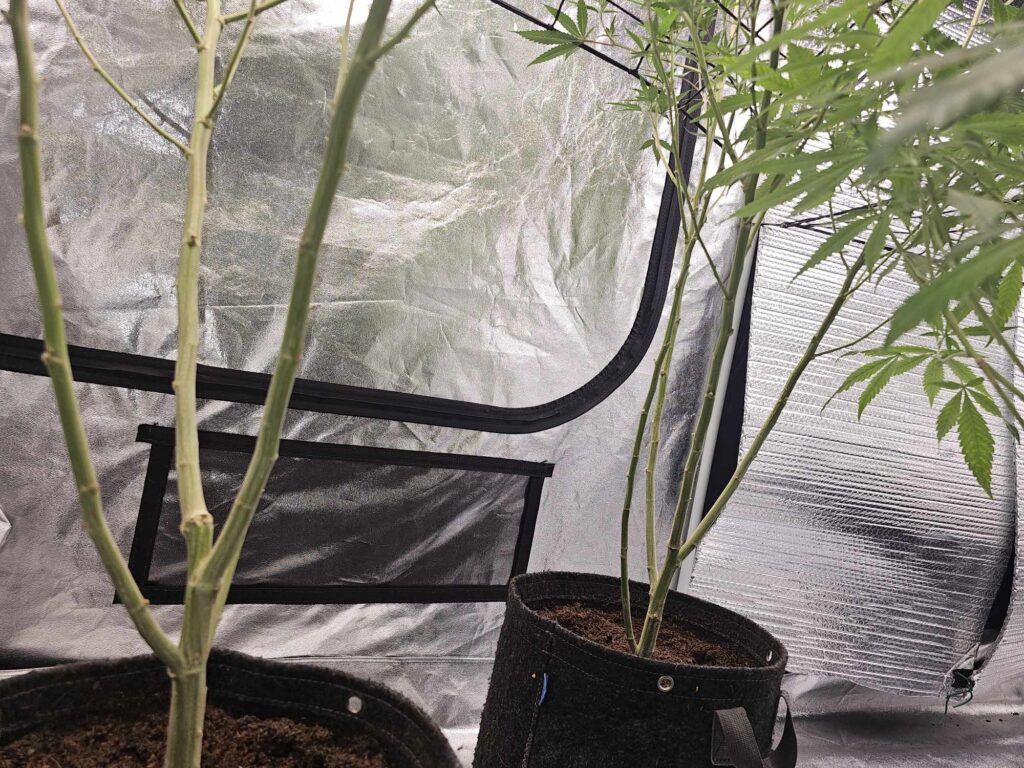
5. Lollipopping
Lollipopping is a targeted cannabis pruning technique aimed at optimizing plant health, light penetration, and ultimately, bud development. This method gets its name from the distinctive look it gives the plants: after pruning, the lower part of the plant is left bare like a lollipop stick, while the top remains dense and bushy, focusing energy on the buds that receive the most light.
Description
Lollipopping involves the removal of lower growth on the cannabis plant that doesn’t receive adequate light or contributes little to the final yield. This typically includes small branches, leaves, and bud sites that are too far from the light source to develop fully. By concentrating the plant’s energy on the upper part of the plant, growers can achieve more significant, denser bud development where it counts.
Benefits
The benefits of lollipopping are twofold: improved air circulation and enhanced light penetration. By removing lower growth, the airflow around the base and middle sections of the plant is significantly increased, reducing the risk of mold and pests that thrive in stagnant, humid conditions. Additionally, with fewer leaves and branches to block the light, more energy is directed to the top of the plant, where the buds have the best chance of developing fully.
Implementing Lollipopping
- Timing: The best time to implement lollipopping is during the late vegetative stage or just before the flowering phase begins. This timing ensures that the plant has enough time to recover from the stress of pruning before it needs to focus all its energy on bud development.
- Selection: Carefully examine your plant to identify which lower branches and leaves are unlikely to receive enough light to produce substantial buds. These are your targets for removal.
- Pruning: Using clean, sharp scissors or pruning shears, carefully remove the selected branches and leaves. Make clean cuts close to the main stem to minimize stress and promote healing.
- Maintenance: After lollipopping, continue to monitor your plant’s growth. Additional light pruning may be necessary as the plant enters and progresses through the flowering stage.
Considerations
While lollipopping can significantly improve yield and plant health, it’s essential to approach it with care. Over-pruning can stress the plant, potentially reducing its overall productivity. It’s crucial to strike a balance, removing enough growth to improve light exposure and airflow without stripping the plant of too many leaves, which are vital for photosynthesis.
Lollipopping is most effective when combined with other training techniques, such as topping or employing a Screen of Green (ScrOG). These methods can help ensure that the remaining upper part of the plant is well-structured and capable of supporting robust bud development.
In summary, lollipopping is a powerful technique for focusing a cannabis plant’s energy where it’s most productive. By strategically removing lower growth, growers can ensure their plants are primed for optimal airflow, light penetration, and, ultimately, the development of large, potent buds.
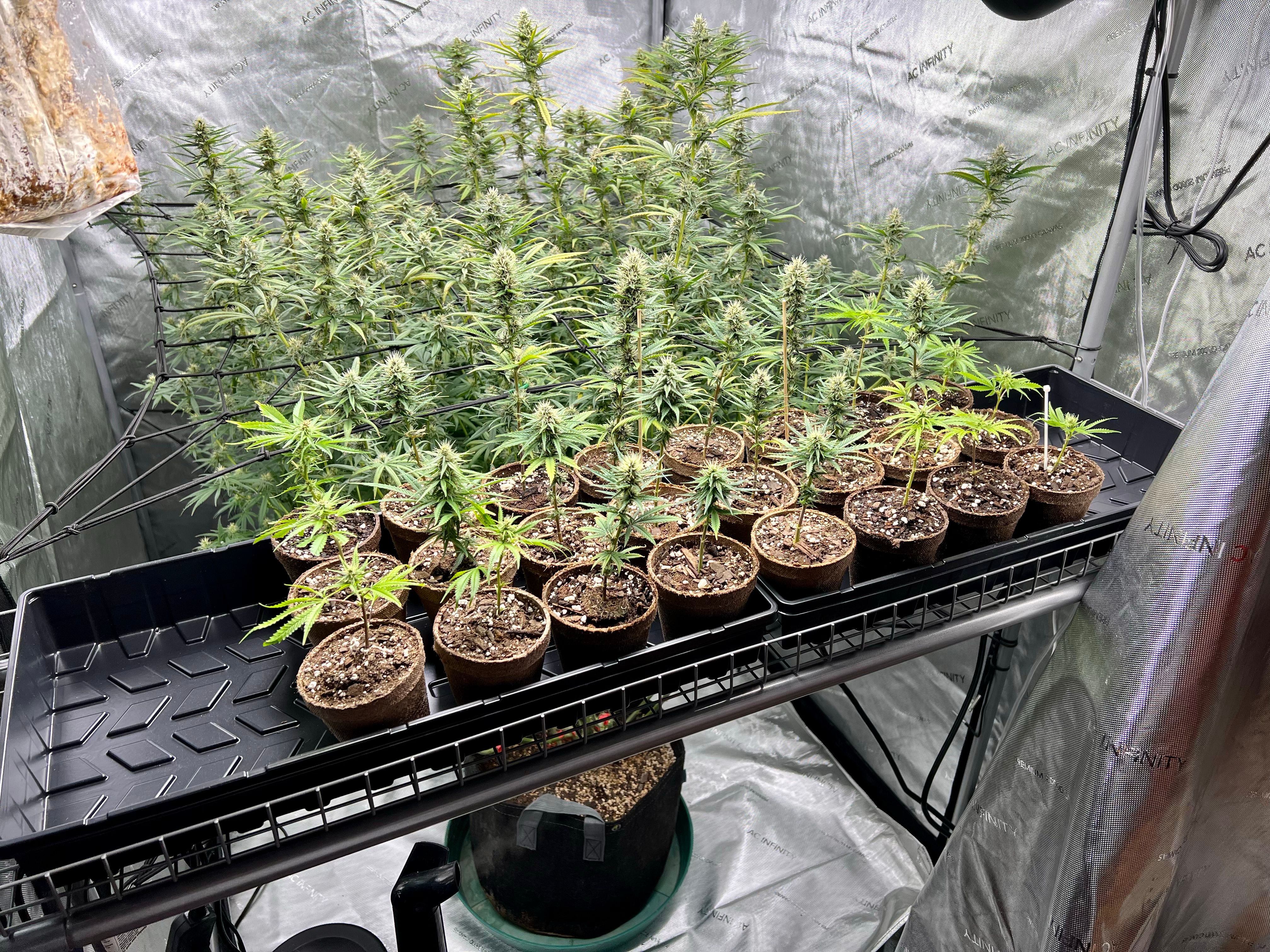
6. Monster Cropping
Monster Cropping, also known as “Flowering Clones,” is a sophisticated cannabis cultivation technique that plays ingeniously with the plant’s life cycle to produce bushier plants, endowed with an abundance of bud sites. This method leverages the stress of reverting a plant from the flowering back to the vegetative stage, encouraging vigorous new growth and a structure ideal for high yields.
Description
Monster Cropping involves taking clones from a cannabis plant that is already in the flowering stage, typically 2-3 weeks into the cycle when the sex of the plant is evident but before the buds fully mature. These clones are then reverted back to vegetative growth under a longer light cycle. The stress induced by this dramatic shift in growth phases stimulates the clones to grow more branches and leaves, leading to a denser, bushier plant structure.
Benefits
The primary benefit of Monster Cropping is the significant increase in bud sites and overall plant density it can produce. Clones that undergo this process tend to be more robust and branchier than those taken during the vegetative phase, leading to potentially higher yields. Additionally, because these clones have already shown their sex, growers can be more confident in their femininity, reducing the risk of unwanted male plants in the grow space.
Monster Cropping also offers a unique advantage in terms of cloning efficiency. Since clones are taken from flowering plants, this method can save space and resources by eliminating the need for maintaining a separate mother plant in perpetual vegetative growth for cloning purposes.
Implementing Monster Cropping
- Selecting Clones: Choose healthy branches from a flowering plant, ideally with visible bud sites but before the buds have begun to mature significantly.
- Cutting and Rooting: Cut the selected branches at a 45-degree angle, and place them in a rooting medium. Ensure the clones are kept under a light cycle conducive to vegetative growth (e.g., 18 hours of light and 6 hours of darkness).
- Reverting to Vegetative Growth: Maintain a high humidity level and a consistent lighting schedule to encourage the clones to revert to the vegetative stage. This process can take longer than rooting typical vegetative clones, so patience is essential.
- Caring for Monster Cropped Plants: Once the clones have successfully reverted and begun to show new vegetative growth, treat them as you would any other vegetative plant, with appropriate nutrients, light, and water.
Considerations
Monster Cropping is a more advanced technique that requires a good understanding of cannabis growth cycles and patience during the reversion process. The stress induced by this method can sometimes lead to slower initial growth as the plant acclimatizes to its new phase. However, with careful management, the resulting plants can be incredibly productive.
This technique is particularly well-suited to indoor growers who have control over their lighting schedule, as managing the light cycle is crucial for reverting the clones to vegetative growth. Monster Cropping can be combined with other training techniques, such as ScrOG or LST, to maximize the potential of the bushier growth pattern.
Monster Cropping stands as a testament to the innovative spirit of cannabis cultivators, offering a unique method to enhance yield and plant robustness. By understanding and leveraging the plant’s natural responses to stress, growers can unlock an exciting avenue for optimizing their cultivation practices.
Considerations and Tips for Successful Cannabis Training
When embarking on the journey of advanced cannabis training techniques, it’s crucial to approach with mindfulness and respect for the plant’s needs and responses. These techniques, while potent in maximizing yield and improving quality, require a nuanced understanding of cannabis physiology, stress management, and timing. Here are some key considerations and tips to ensure your success:
Stress Management
- Understand Plant Stress: Recognize that while stress can stimulate growth and resilience, too much can harm your plants. Monitor your plants closely for signs of distress, including stunted growth, discoloration, or drooping.
- Gradual Introduction: When applying high-stress techniques like supercropping or defoliation, introduce them gradually. Allow your plants time to recover before implementing additional stressors.
Hygiene
- Sterilize Your Tools: Always use clean, sterilized pruning shears or scissors to prevent the spread of disease when cutting or handling your plants.
- Clean Work Area: Keep your growing area clean and tidy to reduce the risk of pests and diseases.
Training Timing
- Vegetative Phase: Most training techniques are best applied during the vegetative growth stage when plants are most flexible and resilient.
- Flowering Phase Caution: Be cautious with training techniques during the flowering phase, as plants are more sensitive and can be easily stressed, affecting bud development.
Genetic Considerations
- Strain Differences: Recognize that different cannabis strains may respond differently to training techniques. Indica-dominant strains might not stretch as much as sativa-dominant strains, affecting the applicability and effectiveness of certain methods.
- Research Your Strain: Before implementing advanced training techniques, research your specific strain’s growth patterns and stress tolerance.
Consistency and Observation
- Consistent Care: Successful cannabis training requires consistent care and attention. Regularly inspect your plants for growth progress, potential issues, and their general health.
- Adapt and Adjust: Be prepared to adapt your approach based on your observations. What works for one plant or strain might not work for another.
Patience and Learning
- Patience Is Key: Advanced training techniques often require time to see results. Be patient and give your plants the time they need to adapt and respond.
- Continuous Learning: The world of cannabis cultivation is ever-evolving. Stay curious, and continue learning about new techniques, technologies, and strategies to improve your cultivation practice.
Mastering advanced cannabis training techniques can significantly elevate your cultivation experience, offering not just higher yields but also superior quality and potency in your plants. Techniques like main-lining, ScrOG, supercropping, defoliation, lollipopping, and monster cropping demand precision and a deep understanding of plant growth. By implementing these methods, you can maximize the genetic potential of your cannabis plants, ensuring robust growth and optimal production.
To further enhance your cultivation practice, consider integrating cannabis companion plants, which can provide numerous benefits such as pest control, improved soil health, and enhanced plant growth. For more information on this topic, check out our article on 12 Amazing Cannabis Companion Plants. This guide explores various plants that can be paired with cannabis to create a more resilient and productive garden.
Additional Resources:
- Grow That Sh!t Better by Maximus Reigns – An essential eBook for both novice and experienced growers, offering advanced techniques and tips for improving cannabis cultivation.
- Cannabis Growers’ Handbook by Ed Rosenthal – A comprehensive guide that covers all aspects of growing cannabis, from setup to harvest.
- Royal Queen Seeds Blog – A rich resource for growers, featuring articles on growing techniques, strain information, and more.
- Need Cannabis Seeds? – Seedsman Seeds has a variety of seeds for all growers from new and seasoned to medical and CBD users.
- Grow Weed Easy – A website dedicated to providing step-by-step guides and resources for growing cannabis at home.
By combining advanced training techniques with effective companion planting, you can create a thriving, balanced garden that not only produces high-quality cannabis but also supports a sustainable and healthy growing environment. Happy growing!


